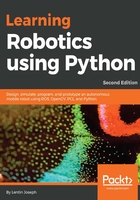
What this book covers
Chapter 1, Getting Started with Robot Operating System, explains the fundamental concepts of ROS, which are the main platform for programming robot.
Chapter 2, Understanding the Basics of Differential Robots, discusses the fundamental concepts of a differential mobile robot. The concepts are Kinematics and Inverse kinematics of differential drive. This will help you implement the differential drive controller in the software.
Chapter 3, Modeling the Differential Drive Robot, discusses the calculation of the robot design constraints and 2D/3D modeling of this mobile robot. The 2D/3D modeling is based on a set of robot requirements. After completing the design and robot modeling, the reader will get the designed parameters that can be used for creating a robot simulation.
Chapter 4, Simulating a Differential Drive Robot Using ROS, introduces a robot simulator named Gazebo and helps readers to simulate their own robot using it.
Chapter 5, Designing ChefBot Hardware and Circuits, discusses the selection of different hardware components required to build Chefbot.
Chapter 6, Interfacing Actuators and Sensors to the Robot Controller, discusses the interfacing of different actuators and sensors used in this robot with Tiva C Launchpad controller.
Chapter 7, Interfacing Vision Sensors with ROS, discusses interfacing of different vision sensors such as Kinect and Orbecc Astra that can be used in Chefbot for autonomous navigation.
Chapter 8, Building ChefBot Hardware and Integration of Software, discusses the complete construction of robot hardware and software in ROS in order to implement autonomous navigation.
Chapter 9, Designing a GUI for a Robot Using Qt and Python, discusses the development of a GUI to command the robot to move to a table in a hotel-like environment.